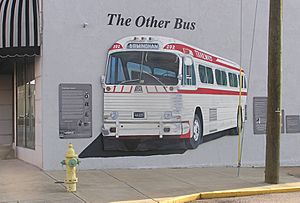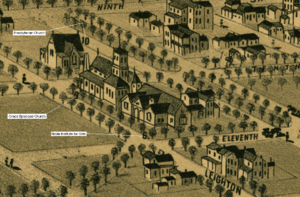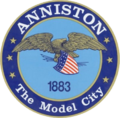Anniston, Alabama facts for kids
Quick facts for kids
Anniston
|
|||||
|---|---|---|---|---|---|
|
City
|
|||||

Downtown Anniston in 2012
|
|||||
|
|||||
| Nickname(s):
The Model City
|
|||||

Location of Anniston in Calhoun County, Alabama.
|
|||||
| Country | United States | ||||
| State | Alabama | ||||
| County | Calhoun | ||||
| Settled | April 1872 | ||||
| Incorporated | July 3, 1883 | ||||
| Area | |||||
| • City | 45.90 sq mi (118.87 km2) | ||||
| • Land | 45.83 sq mi (118.69 km2) | ||||
| • Water | 0.07 sq mi (0.18 km2) | ||||
| Elevation | 719 ft (219 m) | ||||
| Population
(2020)
|
|||||
| • City | 21,564 | ||||
| • Density | 470.57/sq mi (181.69/km2) | ||||
| • Metro | 116,736 (US: 327th) | ||||
| Time zone | UTC-6 (Central (CST)) | ||||
| • Summer (DST) | UTC-5 (CDT) | ||||
| ZIP code |
36201-36207
|
||||
| Area code | 256 | ||||
| FIPS code | 01-01852 | ||||
| GNIS feature ID | 0159066 | ||||
Anniston is a city in Alabama, United States. It is the county seat of Calhoun County. Anniston is part of the Anniston–Oxford Metropolitan Statistical Area. In 2020, about 21,564 people lived there.
A newspaper writer from Atlanta, Henry W. Grady, called Anniston "The Model City." He gave it this name because it was carefully planned in the late 1800s. The city is located on the side of Blue Mountain.
Contents
History of Anniston
Early Days and the Civil War
People started settling in the area around Anniston much earlier. But the valuable minerals there were not used until the American Civil War. During the war, the Confederate States of America ran an iron furnace] near what is now downtown Anniston. Union soldiers on horseback destroyed this furnace in early 1865. After the war, Anniston became known for making cast iron pipes for sewer systems. This type of pipe was very popular until plastic pipes came along in the 1960s.
The Woodstock Iron Company and Growth
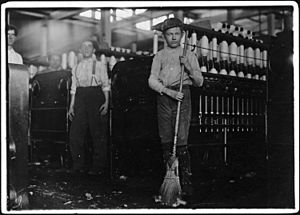
In 1872, the Woodstock Iron Company was started by Samuel Noble and Union General Daniel Tyler. They rebuilt the iron furnace much bigger than before. They also started a planned community. It was first called Woodstock, but later renamed "Annie's Town" after Annie Scott Tyler, who was the wife of a railroad president. This name soon became Anniston. The town officially became a chartered town in 1873.
Even though the town's economy was based on iron, steel, and pipes, its planners also promoted it as a health resort. Several hotels opened. Schools were also built, like the Noble Institute for girls in 1886. The Alabama Presbyterian College for Men opened in 1905. Because of careful planning and good access to railroads, Anniston was the fifth largest city in Alabama from the 1890s to the 1950s.
Anniston During the World Wars
In 1917, when World War I began, the United States Army built a training camp called Fort McClellan in Anniston. On the other side of town, the Anniston Army Depot opened during World War II. It became a major place for storing and fixing weapons. It still does this job today, especially with destroying old munitions. Most of Fort McClellan became part of Anniston in the late 1990s. The Army closed the fort in 1999.
The Civil Rights Era in Anniston
Anniston became very important in national news in 1961 during the Civil Rights Movement. A group of people attacked a bus carrying Freedom Riders. These riders were traveling on an integrated bus to protest Jim Crow segregation laws in Alabama. These laws unfairly denied African Americans their civil rights.
On Mother's Day, May 14, 1961, one of the buses was attacked with fire outside Anniston. As the bus burned, the attackers tried to keep the doors shut. An exploding fuel tank made the attackers move back, allowing the riders to escape. The riders were then attacked as they tried to get away. Highway patrol officers fired warning shots, which helped prevent further harm to the riders. Today, a historic marker stands at this site, which was named Freedom Riders National Monument in 2017.
After this violence, the city created a Human Relations Council (HRC) with white business and religious leaders. On September 15, 1963, the HRC tried to integrate the "whites-only" public library. More conflict happened, and two Black ministers, N.Q. Reynolds and Bob McClain, were attacked. The HRC chairman, Rev. Phil Noble, worked with City Commissioner Miller Sproull to prevent further trouble. President John F. Kennedy sent federal troops to Fort McClellan to help. The next day, Noble and Sproull walked with Black ministers into the library, with city police present. In February 1964, a business owned by the Sproull family was attacked, likely because of Commissioner Sproull's efforts to end segregation.
On July 15, 1965, a Black factory worker named Willie Brewster was killed while driving home from work after a white racist rally in Anniston. Local leaders raised money for a reward, which led to the arrest and conviction of the killer, Damon Strange. This was a very important moment. Historian Taylor Branch called it a "breakthrough verdict." It was the first time an all-white jury in Calhoun County convicted a white person for killing a Black person during the Civil Rights era in Alabama.
Geography and Climate
Anniston is located at the southern end of the Blue Ridge Mountains, which are part of the Appalachian Mountains. This area is home to many different kinds of birds, reptiles, and mammals. Part of the old Fort McClellan is now the Mountain Longleaf National Wildlife Refuge. This refuge helps protect endangered Southern Longleaf Pine trees.
Anniston is located at 33°39′46″N 85°49′35″W / 33.66278°N 85.82639°W.
The United States Census Bureau says that Anniston covers about 45.7 square miles (118.4 square kilometers). Most of this area is land, with a small amount of water. In 2003, part of the nearby town of Blue Mountain became part of Anniston.
Anniston's Weather
Anniston has hot, humid summers and generally mild to cool winters. This type of weather is called a humid subtropical climate.
| Climate data for Anniston, Alabama | |||||||||||||
|---|---|---|---|---|---|---|---|---|---|---|---|---|---|
| Month | Jan | Feb | Mar | Apr | May | Jun | Jul | Aug | Sep | Oct | Nov | Dec | Year |
| Mean daily maximum °C (°F) | 14 (57) |
16 (60) |
18 (65) |
24 (75) |
29 (84) |
32 (90) |
33 (92) |
33 (92) |
30 (86) |
24 (76) |
18 (64) |
14 (57) |
24 (75) |
| Mean daily minimum °C (°F) | 2 (35) |
3 (37) |
5 (41) |
9 (49) |
14 (57) |
18 (65) |
20 (68) |
19 (67) |
16 (61) |
9 (49) |
3 (37) |
1 (34) |
10 (50) |
| Average precipitation cm (inches) | 13 (5) |
13 (5) |
14 (5.7) |
11 (4.3) |
8.4 (3.3) |
11 (4.3) |
9.9 (3.9) |
9.1 (3.6) |
10 (4) |
5.6 (2.2) |
9.4 (3.7) |
11 (4.3) |
125 (49.3) |
| Source: Weatherbase | |||||||||||||
People of Anniston
| Historical population | |||
|---|---|---|---|
| Census | Pop. | %± | |
| 1880 | 942 | — | |
| 1890 | 9,998 | 961.4% | |
| 1900 | 9,695 | −3.0% | |
| 1910 | 12,794 | 32.0% | |
| 1920 | 17,734 | 38.6% | |
| 1930 | 22,345 | 26.0% | |
| 1940 | 25,523 | 14.2% | |
| 1950 | 31,066 | 21.7% | |
| 1960 | 33,320 | 7.3% | |
| 1970 | 31,533 | −5.4% | |
| 1980 | 29,135 | −7.6% | |
| 1990 | 26,623 | −8.6% | |
| 2000 | 24,276 | −8.8% | |
| 2010 | 23,106 | −4.8% | |
| 2020 | 21,564 | −6.7% | |
| U.S. Decennial Census 2018 Estimate |
|||
Anniston first appeared in the U.S. Census in 1880 as a town.
Anniston's Population in 2020
| Race | Num. | Perc. |
|---|---|---|
| White (not Hispanic) | 9,012 | 41.79% |
| Black or African American (not Hispanic) | 10,565 | 48.99% |
| Native American | 52 | 0.24% |
| Asian | 245 | 1.14% |
| Pacific Islander | 10 | 0.05% |
| Other/Mixed | 768 | 3.56% |
| Hispanic or Latino | 912 | 4.23% |
In the 2020 United States census, there were 21,564 people living in Anniston. There were 9,277 households and 5,455 families.
Anniston's Population in 2010
In the 2010 census, Anniston had 23,106 people. About 51.5% of the people were Black or African American. Around 43.6% were White (not Hispanic). Other groups included Native American, Asian, and Pacific Islander people. About 2.7% of the population was Hispanic or Latino.
There were 9,603 households. About 20.3% of these had children under 18. The average household had 2.26 people. The average family had 2.91 people.
The median age in the city was 39 years old. This means half the people were younger than 39 and half were older.
Arts and Culture in Anniston
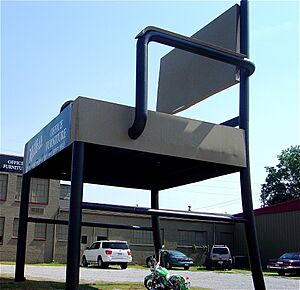
In 1899, Anniston became the county seat of Calhoun County. More than 100 years later, it is a busy center for business and industry. The city has worked to keep its natural beauty and history. The Spirit of Anniston Main Street Program, started in 1993, has helped restore and improve downtown Anniston, especially Noble Street.
This effort included fixing up historic homes and businesses. The historic Calhoun County Courthouse was also restored. The original building burned down in 1931 but was rebuilt a year later. It was fully restored in 1990 and is still used today.
Anniston has been an important cultural center for northeastern Alabama for a long time. The Alabama Shakespeare Festival started here in 1972. It later moved to Montgomery in 1985. The Knox Concert Series brings famous music and dance shows to Anniston every year. The Community Actors' Studio Theatre (CAST) performs plays and musicals with local actors. CAST also has special programs to teach children about the arts for free.
The city is home to the Anniston Museum of Natural History and the Berman Museum of World History. These museums have interesting displays, including mummies, wildlife scenes, and old artifacts. The Alabama Symphony Orchestra has performed summer concerts at the former Fort McClellan since 2004.
Anniston has many beautiful Victorian-style homes. Many of them have been restored. Several churches in the city are also historically or architecturally important. These include the Church of St. Michael and All Angels and Mount Zion Missionary Baptist Church. Temple Beth El, built in 1893, is the oldest building in Alabama still used for Jewish worship.
Noble Street, the original main street, is becoming a popular area for shopping and dining again.
The Chief Ladiga Trail starts in Anniston. This paved trail is part of a 90-mile (145 km) path that connects with the Silver Comet Trail in Georgia.
Fort McClellan's Legacy
Fort McClellan was once a U.S. Army training site. It was used for military police, infantry training, and chemical warfare training. It also housed the Women's Army Corps Headquarters. The fort was closed in the 1990s.
Today, part of the former fort is used by the Alabama National Guard for training. Another 9,000 acres (3,642 hectares) became the Mountain Longleaf National Wildlife Refuge in 2003. The United States Department of Homeland Security also uses a part of the fort. This area is called the Center for Domestic Preparedness. It is the only civilian training center in the U.S. where emergency responders can train with real chemical agents in a safe, controlled environment.
Education in Anniston
Public schools in Anniston are managed by Anniston City Schools. These schools include:
- Anniston High School (Grades 9–12)
- Anniston Middle School (Grades 6–8)
- Golden Springs Elementary School (Grades 1–5)
- Randolph Park Elementary School (Grades 1–5)
- Cobb Pre-School Academy (Pre-K)
Some schools in Alabama are listed as "failing" based on state tests. As of early 2018, Anniston High School was in this group.
Jacksonville State University, a public four-year college, is about 12 miles (19 km) north in Jacksonville. Anniston also has smaller campuses of Gadsden State Community College. These are located at the former Fort McClellan and at the Ayers campus.
Several private schools are in Anniston:
- Faith Christian School
- Sacred Heart of Jesus School, a long-standing Catholic school
- The Donoho School, a school for students from kindergarten to 12th grade that prepares them for college
An obelisk (a tall, thin monument) was put up in 1905. It honors "Dr. Clarence J. Owens, president of the Anniston College for Young Ladies."
| School Name | % Black Students | Note |
|---|---|---|
| Anniston City Population | 52% | |
| The Donoho School (Private) | 8% | |
| Sacred Heart of Jesus Catholic School (Private) | 14% | |
| Faith Christian School (Private) | 6% | |
| Anniston High School (Public) | 95% | |
| Anniston Middle School (Public) | 88% | |
| Golden Springs Elementary School (Public) | 81% | |
| Randolph Park Elementary School (Public) | 95% | |
| Tenth Street Elementary School (Public) | 84% |
One former school in Anniston was the Anniston Normal and Industrial School (1898–c. 1915). It was a private Baptist school for African American students during the time of segregation.
Media and News
Anniston has two daily newspapers: The Birmingham News (statewide edition) and the local paper, The Anniston Star. The company that publishes The Anniston Star also owns newspapers in nearby Jacksonville, Piedmont, and Cleburne County. Local radio stations include WHMA AM and FM, and WHOG 1120 AM.
WEAC-CD is the only TV station that broadcasts directly from the Anniston area. However, many TV stations from Birmingham have towers and news offices here. These include WJSU-TV (which broadcasts for Birmingham's ABC 33/40), WBRC-TV (Fox), and WVTM-TV (NBC). Alabama Public Television built its tallest tower on top of Cheaha Mountain, about 12 miles (19 km) south of Anniston.
City Infrastructure
Transportation in Anniston
Several major highways pass through Anniston:
 U.S. Highway 431 (Anniston Eastern Bypass/Golden Springs Road)
U.S. Highway 431 (Anniston Eastern Bypass/Golden Springs Road) State Route 21 (Quintard Avenue/McClellan Boulevard)
State Route 21 (Quintard Avenue/McClellan Boulevard) State Route 202
State Route 202
The Anniston Western Bypass connects Interstate 20 in Oxford to State Route 202. It has five lanes and helps with traffic to the Anniston Army Depot. There are plans to extend it further.
The Anniston Eastern Bypass was a project to build a four-lane highway. It was helped by federal money in 2009. This bypass opened to traffic in January 2011. As of December 2015, the route is fully open and carries US-431.
Amtrak train service is available at the Anniston station. The Crescent train travels between New Orleans and New York. Southbound trains leave at 10:30 AM, and northbound trains leave at 6:59 PM (Central time).
The Areawide Community Transportation System (ACTS) provides bus services within Anniston and Oxford. The buses run Monday to Friday from 6:00 AM to 6:00 PM, and on Saturdays from 10:00 AM to 5:00 PM. There is no service on Sundays.
Anniston Army Depot's Role
Anniston is home to the Anniston Army Depot. This facility is used to maintain most of the Army's tracked vehicles. The depot also used to store a large amount of chemical weapons. A program was created to destroy these weapons at the Anniston Chemical Agent Disposal Facility. In 2003, the depot began destroying its stockpile of Sarin, VX nerve agent, and mustard blister agent. The destruction of these weapons was finished in 2011. The facility used for this was officially closed in May 2013.
Famous People from Anniston
- Jonathan Allen, NFL football player
- General Edward "Ned" Almond, active during Korean War
- George T. Anderson, Civil War general
- Michael Biehn, actor
- Larry Bowie, former NFL player
- Anne Braden, civil rights activist
- Keith Butler, NFL player and football coach
- Red Byron, NASCAR driver
- B. B. Comer, 33rd Governor of Alabama
- John Craton, classical composer
- Michael Curry, NBA player, Florida Atlantic University head coach
- Cow Cow Davenport, boogie-woogie pianist
- Eric Davis, NFL cornerback
- William Levi Dawson (1899–1990), composer
- Bobby Edwards, country music singer
- Ruth Elder, pilot, first female aviator to attempt to cross the Atlantic in 1927
- Andra Franklin, NFL football player
- David F. Friedman, filmmaker and film producer
- James R. Hall, retired Lieutenant General, U.S. Army
- James Harman, blues singer
- Delvin Lamar Hughley, NFL and Arena Football player
- Ken Hutcherson, NFL player and religious leader
- Thomas Kilby, eighth Lieutenant Governor of Alabama and the 36th Governor of Alabama
- Douglas Leigh, lighting designer
- Perry Lentz, author and professor
- Harry Mabry, television news director and anchor
- Kivuusama Mays, former NFL player
- Lucky Millinder, rhythm and blues and swing bandleader
- George C. Nichopoulos, physician known as Dr. Nick
- Robert Ernest Noble, U.S. Army major general
- Tommy O'Brien, MLB player
- Katherine Orrison, author and film historian
- Will Owsley, Grammy-nominated singer-songwriter
- John L. Pennington, newspaper publisher, governor of Dakota Territory
- Tito Perdue, novelist
- Troymaine Pope, NFL player
- John Reaves, quarterback, University of Florida and NFL
- Mike D. Rogers, congressman
- David Satcher, Surgeon General, 1998–2002
- Patrick "J. Que" Smith, Grammy-winning songwriter
- Tremon Smith, cornerback for the Kansas City Chiefs
- Willie Smith, MLB pitcher and outfielder
- Shannon Spruill, professional wrestler
- Vaughn Stewart, former NFL player
- Vaughn Stewart III, delegate in Maryland General Assembly
- Max Wellborn, chairman and governor of Atlanta Fed
Images for kids
See also
 In Spanish: Anniston (Alabama) para niños
In Spanish: Anniston (Alabama) para niños








